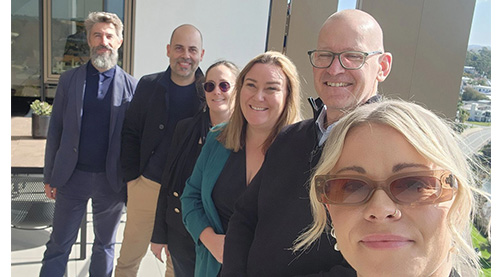Hillam Architects is pleased to announce Alicia Abbott has been promoted to the role of Senior Associate. This promotion reflects both her technical proficiency and her talent in project leadership and delivery, including the recent completion of the Central and Eastern Towers of the Rivière Residences.
In the following article, Alicia reflects on the role of project leads and her individual leadership style of collaboration and empowerment.
Project Leaders live in a world from design right through to delivery. This involves both creativity and control. Every day involves many small decisions: some

technical, some interpersonal, all shaping not only the work we produce but how the team learns to produce it.
I’ve come to realise leadership isn’t about controlling everything or knowing everything; it’s learning to ask the right questions and creating autonomy, purpose and responsibility for each team member to do the same.
Leadership in architecture isn’t about your official title, and it’s not about being the loudest voice in the room (even if I often am!). Leadership is not the person with every answer ready. In truth, it’s about guidance and creating the right environment for others to thrive, the right clarity to keep complex projects moving, and the right balance between trust and accountability.
Sometimes the quietest voice in the room has the thing everyone needs to hear, so I try to make sure those voices have space and safety to speak. Sometimes the best idea comes from the new graduate, and sometimes trial and error is the only way to solve the problem.
In a busy studio, there’s never silence. We are often chopping between emails, consultant mark-ups, Revit model, deadlines creeping closer and multiple tasks at once, all interlinking and connected. Amid that noise, leadership starts with clarity and knowing what matters most today, this week, this phase.
Every project has layers of responsibility: managing clients, guiding design intent, coordinating consultants, mentoring the team. The Project Lead sits at the centre of that web, translating between ambition and practicality.
The role of Project Lead acts as both anchor and conduit:
- The anchor keeps the project steady, aligning programme, quality and resourcing.
- The conduit keeps information moving, upward to directors, sideways to consultants, downward to the emerging team members learning through the process.
It demands patience, empathy, precision and a willingness to admit that the best ideas can start somewhere else.
Documentation phases can involve dozens of active drawings across architecture, interiors and services. No one person can hold every detail, but in the Project Lead position, there’s a requirement to be fully informed of every aspect of the project. So how can we do this with only 24 hours in every day?
Power and Empowerment
I trust my team to come to me, not with problems, but with multiple solutions instead. These solutions need to accompany a recommendation, and often if you can convince me your recommendation is solid enough, this will be the answer.
Incrementally, team members will find their challenges increase in both complexity and quantity. And the more solutions and recommendations you offer and are adopted, the more trust you’ll earn. This is how we build a culture of ownership.
Each team member takes charge of their piece of the puzzle – a drawing set, a detail package, a consultant interface – and the Project Lead is there to give them the clarity, tools and confidence to solve it, run with it or raise it.
That means open communication, visible goals and genuine trust. When people understand why something matters, not just what to do, they start thinking like leaders themselves. That’s when projects gain momentum, not from oversight, but from collective confidence.
The only silly question is the one you didn’t ask.
At Hillam, we are constantly improving and talking about process, systems, templates and QA checklists, but inside those frameworks lives the human element. Everyone learns differently, manages pressure differently, and finds satisfaction in different things. Leadership means understanding those dynamics. Some people need direction; others need room to experiment. Some thrive under pressure; others need protection from the cooker.
When I review drawings, I don’t just look for errors, I look for understanding.

Does the designer know why this decision matters? Do they see how it connects to the bigger picture? Building this understanding hopefully develops a team that not only documents well but thinks like architects.
I’m not perfect at this (far from it). I’ve been known to say, “They’re not building this over the weekend,” when the team looks panicked on a Friday afternoon.
Sometimes the best thing we can do is pause, breathe, and come back Monday with fresh eyes. My approach is to break big challenges into small steps, incremental wins that build confidence. Focus on the next drawing, the next coordination item, the next deadline. Keep your eye on the prize, but don’t stare so hard you miss the progress happening along the way.
Being a Project Lead isn’t about authority; it’s about designing the conditions where good work can happen. That includes program planning, QA, and resourcing but also culture and morale.
The best outcomes happen when people feel safe to contribute, challenge ideas and grow. The project lead role is to hold that space to ensure deadlines and design standards are met, yes, but also that curiosity and learning aren’t casualties of productivity.
Building For the Future
I want to quickly speak about the rewards of “shared Leadership”.
To me, the most rewarding part of leadership is watching others grow into it.
Seeing team members who once looked for instruction now lead coordination meetings, propose new detailing solutions, and challenge consultants with confidence, or not be afraid to ask the next question, to dig deeper for their own understanding – that’s a legacy that lasts longer than any drawing set.
Great buildings will carry the fingerprints of many hands, but a well-led team carries those lessons into every project that follows.

